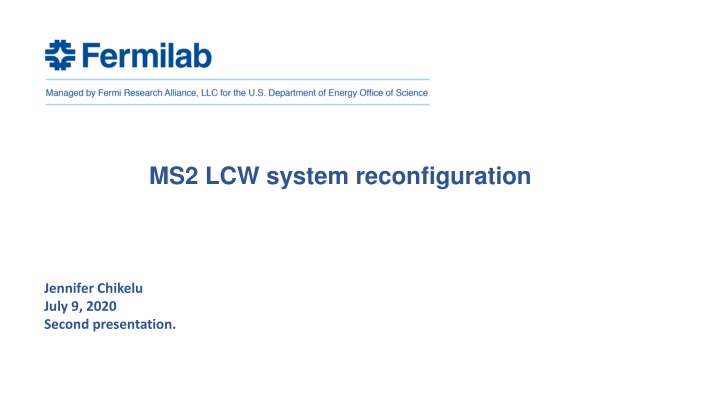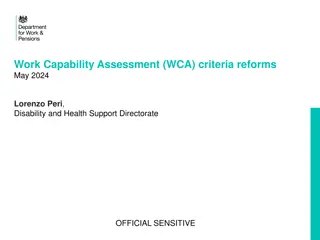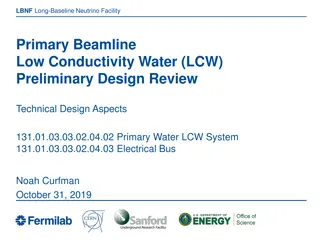
Chiller Sizing and System Design Considerations for Efficient Cooling Solutions
"Explore detailed specifications, design calculations, and considerations for chiller sizing in a system reconfiguration project presented by Jennifer Chikelu. Learn about heat load analysis, loop volume determination, flow rate calculations, and more to optimize your cooling system efficiently."
Download Presentation

Please find below an Image/Link to download the presentation.
The content on the website is provided AS IS for your information and personal use only. It may not be sold, licensed, or shared on other websites without obtaining consent from the author. If you encounter any issues during the download, it is possible that the publisher has removed the file from their server.
You are allowed to download the files provided on this website for personal or commercial use, subject to the condition that they are used lawfully. All files are the property of their respective owners.
The content on the website is provided AS IS for your information and personal use only. It may not be sold, licensed, or shared on other websites without obtaining consent from the author.
E N D
Presentation Transcript
MS2 LCW system reconfiguration Jennifer Chikelu July 9, 2020 Second presentation.
AGENDA P&ID update (parallel/series which is recommended?) Specifications and operating conditions. AFT fathom modelling for secondary loop. Heat exchanger sizing by vendor Chiller pump sizing Reservoir sizing for secondary loop.
P&ID 500 gpm 700 gpm optional
Specifications and design calculations Given; Total system heat load to be 900KW or 3,070,928 Btu/hr. Cooling liquid in secondary loop is 40% by vol glycol and 60% water. The primary loop is just water, design temperature of water supplied to magnets is 90 . The primary loop if supplied at 90 , at 700 gpm to the magnets, the outlet temperature after 900 KW, is 99 . 350 gpm of the hot fluid gets cooled by the heat exchanger. And gets mixed with the other half to a temperature of 90 . 500 gpm @ 49.5 (SL) 350 gpm @ 81 (PL) 350 gpm @ 99 (PL) HX 700 gpm @ 90 (PL) 350 gpm @99 (PL) 500 gpm @63 (SL)
Chiller sizing and design From the LN engrg catalog quoted that recommended that the entering water temperature not exceed 65 F. The chiller must not be operated with a leaving water temperature of less than 42 F for a plain water application . Giving an allowable temperature swing of 2, I decided to design the chiller to have an entering temp of 63 F. Also from the catalog, has correction factors for a propylene glycol and water mixture for capacity, power, pressure drop and flow rate. Determine loop volume based on the equation ?????? ???? ??? ??? (??? ????? ) Minimum water loop volume = ??? ????????? ?????
Minimum water loop volume given an allowable temperature swing of 2 , is 1314.6 gallons. With a 40% PG correction factor, minimum loop volume for system would be 1436 gallons. Typically for process systems, HVAC chiller system volume is sized between 6 to 10 gallons per ton. given a recommended vol/ton of 10gal/ton, our system should be at least 1400 gallons. To size a buffer tank, would be ; Min. Volume of buffer tank = Min. loop vol. Actual system vol.
To determine the chilled water flowrate; GPM = ???? ???? ?????? ? ????? Flow factor is 26.2 for 40%PG, Tons = 140 x capacity correction factor for 40% PG, 0.921 = 129 tons. If we have a flow rate of 250 gpm. The temperature change in water would be 13.52 An entering temperature of 63 and exit temperature of 49.48 . Note: To increase the temp difference a little bit, we can reduce flowrate to 230 gpm.
Chiller has four compressors, 2 on/off scroll and 2 inverter scrolls
Answers to some of the questions asked last discussions
Chiller pump sizing. The chiller will have pump sized to meet refrigeration flow needs around the secondary loop. AFT fathom model to see flow requirements, and the system was modelled by input into the system density and viscosity of 40% PG to water at 50 F. Density used was 65 lb/ft ^3, and dynamic viscosity of 7.21 cP. The evaporator has a pressure drop of 9.5 ftH2O, for 40%PG, pressure drop factor of 1.67, its pressure drop is 15.9 ft; which is 7.2 psig with the given density The heat exchanger pressure drop is estimated to be 10 psig, with an elevation change of 12 ft. The pipe dimensions for 500 gpm flow is 5 SCH 10, and for 250 gpm flow is 4 SCH 10.



